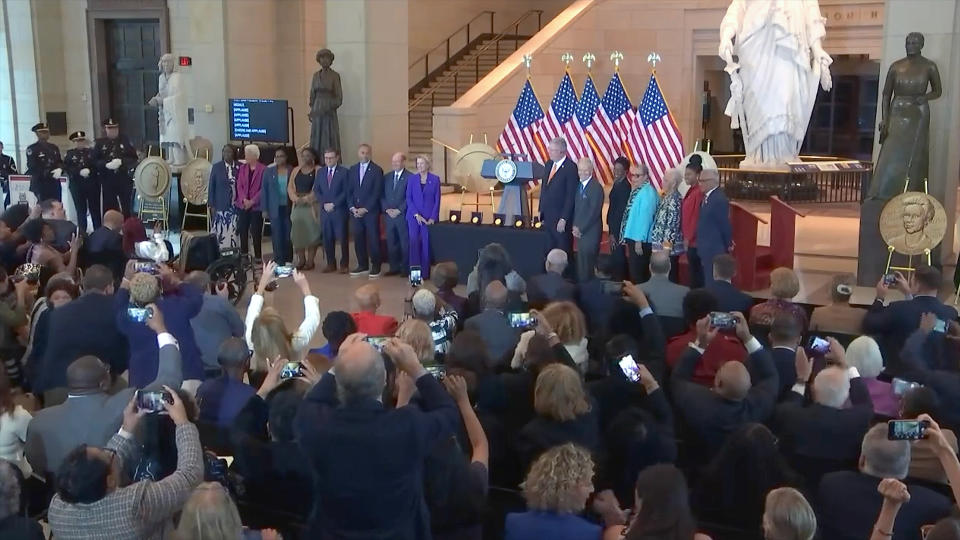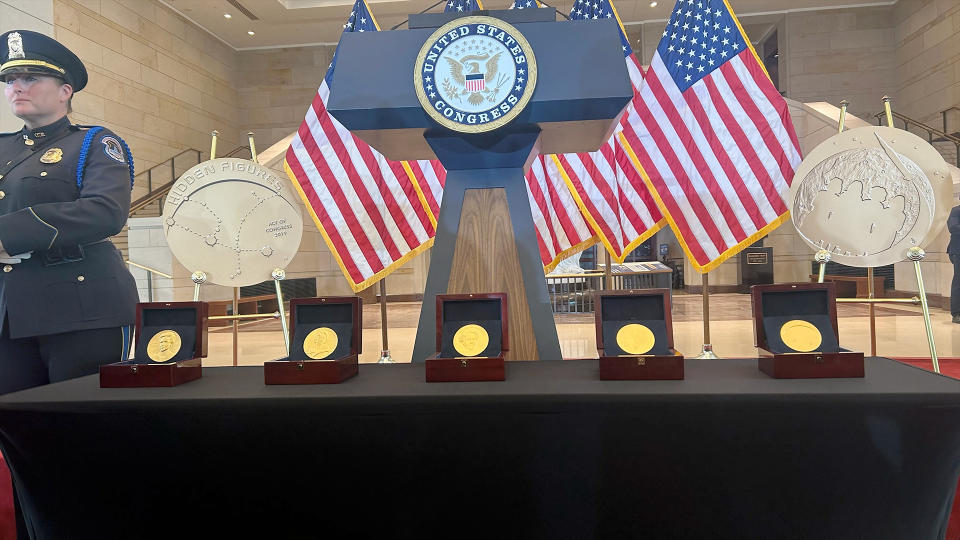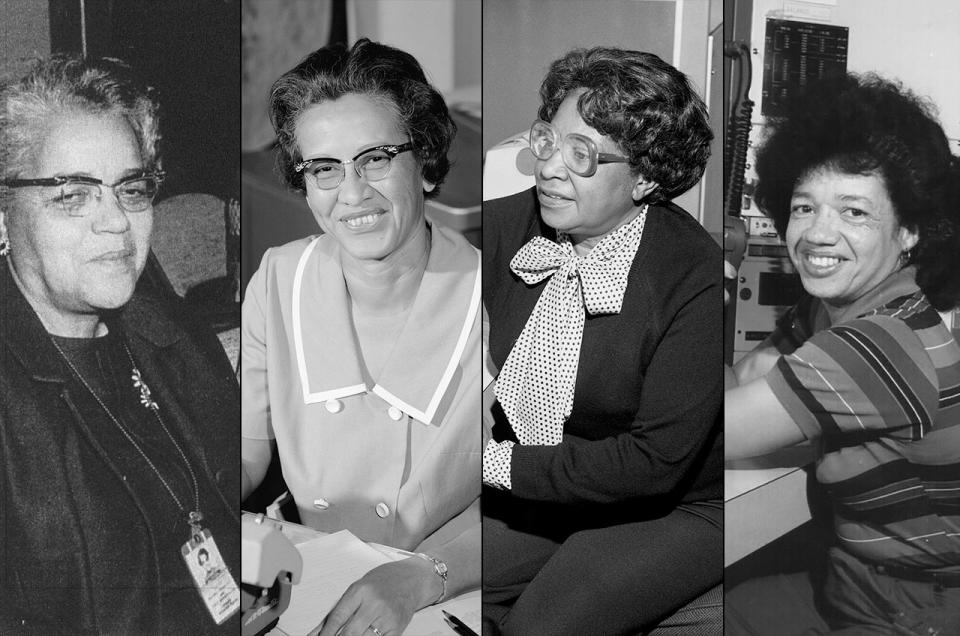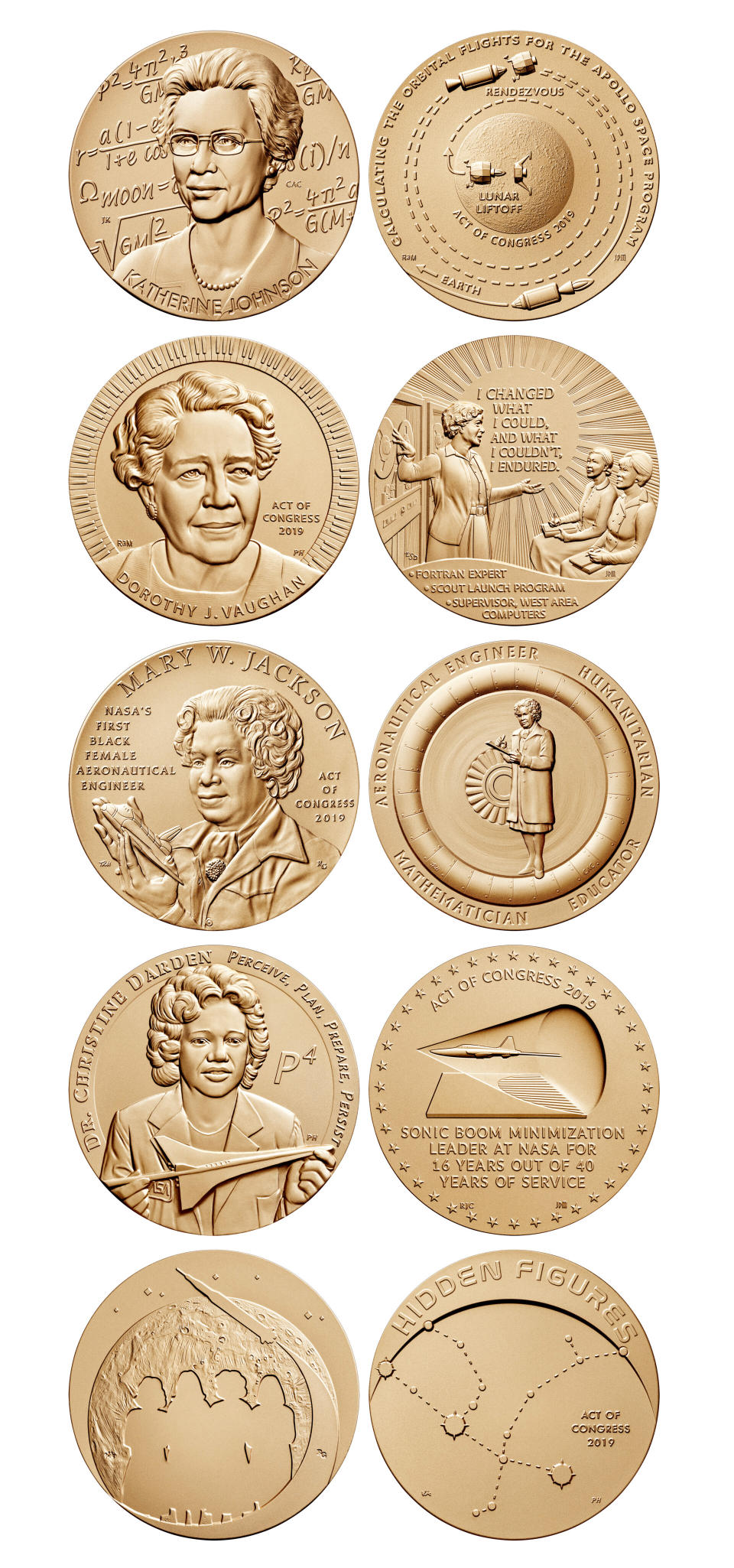When you buy through links in our articles, Future and its syndication partners may earn a commission.

While they may never lose the label entirely, the women who worked as NASA’s human computers during the space race are no longer “hidden figures.” Now, they have a medal to prove it.
On Wednesday (Sept. 18), the women as a group and four individuals representing their collective experiences were presented with the Congressional Gold Medal, one of the highest civilian honors in the United States. As authorized by Congress, the medals were awarded to Christine Darden and posthumously to Katherine Johnson, Mary Jackson, and Dorothy Vaughan.
A separate Hidden Figures Congressional Gold Medal was also awarded to all women who worked as mathematicians and engineers at NACA (National Advisory Committee for Aeronautics) and NASA between the 1930s and the 1970s.
“These women didn’t just crunch numbers and solve equations,” said Rep. Mike Johnson, Speaker of the U.S. House of Representatives. “They actually laid the foundation upon which our rockets launched and our astronauts flew and our nation soared.”
“Today, it is my great honor to award these women the Congressional Gold Medal for all their contributions to the space program and to society,” Johnson said.


The ceremony, hosted by the chairman, brought together fellow representatives and senators, NASA officials and the families of Johnson, Jackson, Vaughan and Darden at Emancipation Hall in the Capitol in Washington. (Darden watched live from her home in Connecticut.)
Related: Facts About NASA’s Real ‘Hidden Figures’
“The remarkable things that NASA accomplishes and that America accomplishes build on the pioneers who came before us, people like the women of Mercury and Gemini and Apollo,” said Bill Nelson, NASA Administrator. “The women we honor today made it possible for Earth’s inhabitants to go beyond the boundaries of Earth.”
The guests’ contributions to the space program were first highlighted in Margot Lee Shetterly’s 2016 book Hidden Figures, which in turn inspired the feature film of the same name starring Taraji P. Henson, Janelle Monáe and Octavia Spencer as Johnson, Jackson and Vaughan.
Assigned to the Space Task Group, Johnson calculated trajectories for NASA’s early human spaceflights, including the suborbital launch of the first American in space, Alan Shepard, and the first flight of an American astronaut in orbit, John Glenn. Johnson, who died in 2020 at age 101, was the first woman in NASA’s flight research division to be recognized as an author of a research paper.
In 2015, Johnson was awarded the Presidential Medal of Freedom. A year later, NASA named Langley’s then-new Computational Research Facility after her.
Vaughan led the West Area Computing unit at what is now the Langley Research Center in Virginia, and became the first African-American supervisor at NACA. She later became a leading computer programmer as part of NASA’s Analysis and Computation Division. Vaughan died in 2008 at the age of 98.
Earlier this year, NASA’s Johnson Space Center in Houston celebrated the 55th anniversary of the first moon landing by dedicating one of its original buildings as the “Dorothy Vaughan Center Honoring the Women of Apollo.”


Jackson was the first African-American female engineer at NASA. Later in her career, she worked to improve the prospects of female mathematicians, engineers, and scientists at NASA as manager of Langley’s Federal Women’s Program. She died in 2005 at the age of 83.
In 2021, NASA honored Jackson with the naming of its headquarters building in Washington.
Darden, now 82, became an engineer at NASA 16 years after Jackson. He wrote more than 50 papers on aircraft design and was the first African-American of any gender to be promoted to Senior Executive Service at Langley.
There were hundreds, if not thousands, of other women, both white and black, stationed at NASA facilities and centers, performing calculations before electronic computers were available. Many of their names are lost to history, although their roles are now well known.
In honor of all of them, the stretch of E Street in front of the Mary W. Jackson NASA headquarters was renamed “Hidden Figures Way” in 2019.
“To all the other women who have served our country throughout NASA’s history as computers, mathematicians, data analysts, engineers and scientists, women who are still largely hidden figures, women from all walks of life and all corners of our great country, I’m thrilled that we celebrate you today as well,” Shetterly said.
“It is an honor and a privilege to be here, representing the many women of Apollo and the space program who have dedicated their lives and talents to ensuring that the sky is never the limit,” said Andrea Mosie, senior Apollo sample processor and lab manager at Johnson Space Center. “Thank you for purposefully seeking diverse perspectives on solutions to humanity’s challenges of living beyond the planet.”
Related: Facts About NASA’s Apollo 11 Mission


RELATED STORIES:
—What was the space race?
— NASA unveils ‘Hidden Figures Way’ at headquarters to honor female space icons
— Q&A with the Author: Margot Lee Shetterly Reveals NASA’s ‘Hidden Figures’
The Hidden Figures Congressional Gold Medal Act was first introduced in 2018 by the late Eddie Bernice Johnson (D-Tex.) and Frank Lucas (R-Okla.) in the U.S. House of Representatives. A companion bill followed in the Senate, led by Chris Coons (D-Del.), Lisa Murkowski (R-Alaska), and then-Sen. (D-Calif.) and now Vice President Kamala Harris.
The Hidden Figures Act was passed in 2019 and requires Vaughan’s medal to be donated to the Smithsonian so it can be displayed at the National Museum of African American History and Culture in Washington.
Since 1776 and its presentation to George Washington, the Congressional Gold Medal has been awarded to individuals whose impact on American history is likely to be recognized in the recipient’s field of study for many years to come. Only five other recipients have made contributions to space exploration: rocket pioneer Robert Goddard in 1959 and astronauts John Glenn, Neil Armstrong, Buzz Aldrin and Michael Collins in 2011.
As directed by Congress, the Treasury Secretary determined the design for each of the Hidden Figures gold medals. The U.S. Mint produced bronze replicas of the medals, which were put up for sale at the end of Wednesday’s ceremony.
To follow collectSPACE.com on Facebook and on Twitter via @collectSPACE. Copyright 2024 collectSPACE.com. All rights reserved.